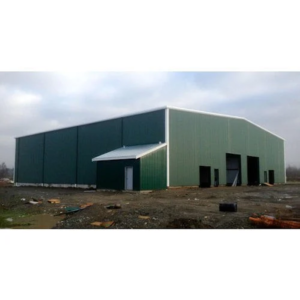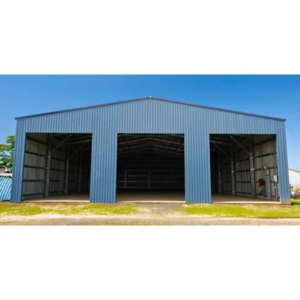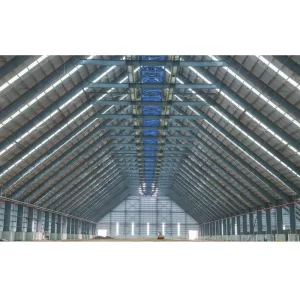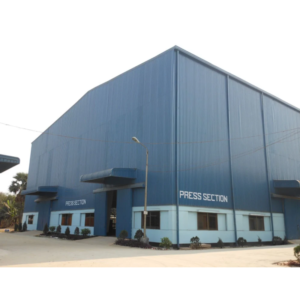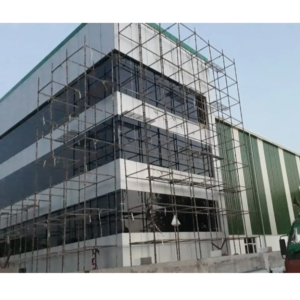Prefabricated Warehouse
Prefabricated Warehouses: The Smart Choice for Efficient Storage Solutions
Introduction to Prefabricated Warehouses
In today’s fast-paced business environment, efficiency and adaptability are paramount. As companies grow, their storage needs often expand, necessitating reliable and flexible solutions. Prefabricated warehouses have emerged as a popular choice for businesses seeking quick, cost-effective, and high-quality storage facilities. These structures are manufactured off-site and assembled on-site, offering a versatile solution for a wide range of industries, including logistics, manufacturing, retail, and e-commerce.
This comprehensive guide will delve into the concept of prefabricated warehouses, their benefits, types, key features to consider, installation processes, maintenance tips, and frequently asked questions.
What is a Prefabricated Warehouse?
A prefabricated warehouse is a building constructed using pre-manufactured components, such as panels, frames, and roofing systems, which are fabricated in a factory. Once completed, these components are transported to the construction site for assembly. This method of construction not only speeds up the building process but also allows for greater quality control, reduced waste, and cost savings compared to traditional construction methods.
Key Features of Prefabricated Warehouses
- Modular Design: Prefabricated warehouses can be designed in modules, allowing for easy customization to fit specific storage needs and site conditions.
- Rapid Construction: The off-site manufacturing process means that on-site assembly can be completed in a fraction of the time it takes for conventional buildings.
- Quality Assurance: Factory conditions provide better oversight, resulting in higher quality construction and fewer defects.
- Energy Efficiency: Many prefabricated warehouses incorporate energy-efficient materials and systems, helping businesses reduce operating costs.
- Scalability: These warehouses can be easily expanded or modified as business needs change, making them a flexible option for growing companies.
Benefits of Prefabricated Warehouses
Choosing a prefabricated warehouse comes with numerous advantages:
1. Cost Savings
One of the most significant benefits of prefabricated warehouses is cost savings. The streamlined construction process reduces labor costs and minimizes material waste, leading to lower overall project expenses.
2. Time Efficiency
The ability to construct a warehouse off-site while preparing the site simultaneously significantly reduces construction timelines. Many projects can be completed within weeks rather than months.
3. High Quality Control
Prefabricated warehouses are built in controlled environments, allowing for better quality assurance and adherence to safety standards. This reduces the likelihood of construction delays due to weather or other on-site issues.
4. Customization Options
Prefabricated warehouses can be tailored to meet specific needs. This includes various sizes, layouts, and designs, allowing businesses to optimize their storage capabilities.
5. Reduced Environmental Impact
The prefabrication process is often more sustainable than traditional construction, as it generates less waste and can utilize eco-friendly materials. Many manufacturers prioritize sustainability in their building practices.
6. Improved Safety
Constructing warehouses in a factory setting reduces on-site safety hazards for workers. The controlled environment allows for better implementation of safety protocols.
Types of Prefabricated Warehouses
Prefabricated warehouses come in various forms to cater to different industries and purposes. Here are some of the most common types:
1. Standard Prefabricated Warehouses
These are basic warehouse structures designed for general storage needs. They typically feature open floor plans and high ceilings to maximize usable space.
2. Climate-Controlled Warehouses
Ideal for businesses that store temperature-sensitive products, climate-controlled warehouses maintain specific temperature and humidity levels to protect goods.
3. Multi-Story Warehouses
For businesses with limited land space, multi-story prefabricated warehouses offer additional storage capacity without requiring a larger footprint.
4. Customized Warehouses
These warehouses are designed to meet the unique requirements of specific industries, such as pharmaceuticals, food storage, or hazardous materials. Custom features may include specialized ventilation systems, reinforced structures, or advanced fire suppression systems.
5. Temporary Warehouses
Perfect for short-term storage needs, temporary prefabricated warehouses can be quickly assembled and disassembled, making them ideal for construction sites or seasonal businesses.
Key Features to Consider When Buying a Prefabricated Warehouse
When selecting a prefabricated warehouse, it’s crucial to consider several factors to ensure you choose the right building for your needs:
1. Size and Capacity
Assess your storage requirements and select a warehouse size that meets your current and future needs. Consider factors such as ceiling height, door sizes, and layout options.
2. Building Code Compliance
Ensure that the prefabricated warehouse complies with local building codes and regulations. This is essential for safety and legality.
3. Insulation and Climate Control
If you plan to store temperature-sensitive items, consider options for insulation and climate control systems to maintain optimal conditions.
4. Material Quality
Choose a warehouse constructed from high-quality materials that offer durability and longevity. Look for features such as rust-resistant steel and weatherproof insulation.
5. Energy Efficiency Features
Opt for energy-efficient designs, including proper insulation, energy-efficient windows, and sustainable materials. These features can help lower operating costs over time.
6. Customization Options
Consider the ability to customize the warehouse to meet your specific needs, such as adding shelving, office space, or loading docks.
7. Manufacturer Reputation
Research the manufacturer’s reputation, experience, and customer reviews. A reliable company can provide quality products and excellent customer support.
Installation Process for Prefabricated Warehouses
The installation of a prefabricated warehouse involves several key steps:
1. Site Preparation
Before construction begins, the site must be prepared. This includes clearing the area, leveling the ground, and laying the foundation according to specifications.
2. Delivery of Components
Once the site is ready, the prefabricated components are delivered. This typically includes panels, frames, roofing materials, and any additional features.
3. Assembly
The assembly process begins with the erection of the warehouse. Skilled laborers carefully construct the building, ensuring that all components fit correctly and securely.
4. Utility Connections
After the structure is assembled, connections for utilities such as plumbing, electrical systems, and HVAC are installed.
5. Finishing Touches
Final touches, such as painting, interior finishes, and landscaping, are completed to prepare the warehouse for operation.
6. Inspection and Quality Assurance
A final inspection is conducted to ensure compliance with building codes and safety regulations. Any necessary adjustments are made to meet standards.
Maintenance Tips for Prefabricated Warehouses
To ensure the longevity and functionality of your prefabricated warehouse, regular maintenance is essential. Here are some tips:
- Regular Inspections: Conduct periodic inspections to identify any signs of wear and tear, particularly in the roof, walls, and foundation.
- Clean Gutters and Drains: Ensure that gutters and drainage systems are clear to prevent water accumulation, which can lead to damage.
- Check Seals and Insulation: Inspect door and window seals for integrity. Replace any damaged seals to maintain energy efficiency.
- Maintain HVAC Systems: Schedule regular maintenance for heating, ventilation, and air conditioning (HVAC) systems to ensure optimal performance.
- Pest Control: Implement preventative measures to avoid pest infestations, which can damage stored goods and compromise warehouse integrity.
- Monitor Fire Safety Systems: Regularly check fire suppression systems and smoke detectors to ensure they are functioning correctly.
Frequently Asked Questions (FAQs)
1. What are the advantages of prefabricated warehouses over traditional warehouses?
Prefabricated warehouses offer cost savings, faster construction times, better quality control, and reduced environmental impact compared to traditional warehouses.
2. How long does it take to construct a prefabricated warehouse?
Construction timelines vary based on size and complexity, but many prefabricated warehouses can be completed within weeks rather than months.
3. Can I customize a prefabricated warehouse?
Yes, prefabricated warehouses can be customized to meet specific design and functional needs, including layout, size, and special features.
4. Are prefabricated warehouses energy-efficient?
Many prefabricated warehouses are designed with energy-efficient materials and systems, helping to reduce operating costs and environmental impact.
5. What types of businesses can benefit from prefabricated warehouses?
Various industries, including logistics, manufacturing, retail, and e-commerce, can benefit from the flexibility and cost-effectiveness of prefabricated warehouses.
6. Do prefabricated warehouses comply with building codes?
Yes, prefabricated warehouses are constructed to meet local building codes and regulations, ensuring safety and compliance.
7. How are prefabricated components transported to the site?
Prefabricated components are typically transported by truck to the construction site, where they are assembled into the final structure.
8. What maintenance is required for prefabricated warehouses?
Maintenance includes regular inspections, cleaning, and upkeep of utilities and exterior elements, similar to traditional warehouses.
9. Can prefabricated warehouses be relocated?
Yes, many prefabricated warehouses can be disassembled and relocated, making them a flexible option for changing business needs.
10. What is the lifespan of a prefabricated warehouse?
With proper maintenance, a prefabricated warehouse can last as long as traditional warehouses, often exceeding 30 years or more.
Conclusion
Prefabricated warehouses offer a modern solution to the storage challenges faced by businesses in various industries. With their cost-effectiveness, quick construction times, and adaptability, these structures are well-suited to meet the evolving demands of today’s fast-paced business landscape.
By understanding the benefits, types, and key features of prefabricated warehouses, you can make informed decisions for your storage needs. Whether you require a standard warehouse, a climate-controlled facility, or a custom-designed structure, prefabricated warehouses represent a smart investment for your business.

